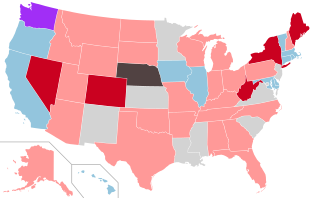| |||||||||||||||||||||||||
87 legislative chambers 46 states | |||||||||||||||||||||||||
|---|---|---|---|---|---|---|---|---|---|---|---|---|---|---|---|---|---|---|---|---|---|---|---|---|---|
| |||||||||||||||||||||||||
 Map of upper house elections: Democrats retained control Republicans gained control Republicans retained control Coalition retained control Non-partisan legislature No regularly-scheduled elections | |||||||||||||||||||||||||
 Map of lower house elections: Democrats retained control Republicans gained control Republicans retained control Non-partisan legislature No regularly-scheduled elections | |||||||||||||||||||||||||
Elections to state legislatures were held in 46 U.S. states in 2014 with a total of 6,049 seats up for election (82 percent of the total number of state legislative seats in the United States). Six territorial chambers were up in four territories and the District of Columbia.
Prior to the general election, Republicans regained control of the Virginia Senate after winning a decisive August special election.[1] They had lost control at the start of the year due to the election of Democratic lieutenant governor Ralph Northam.
In the general election, Republicans initially gained control of nine legislative chambers: both chambers of the Nevada Legislature (which they held simultaneously for the first time since 1931), the Minnesota House of Representatives, the New Hampshire House of Representatives, the New Mexico House of Representatives for the first time since 1955, the West Virginia House of Delegates, the Colorado Senate, the Maine Senate, and the New York Senate, which was previously under a Republican-led coalition. This increased the total number of Republican-controlled state houses from 58 to 67. The day after the election, Republicans, who achieved a 17–17 tie in the West Virginia Senate, gained control of that chamber as well thanks to the defection of State Senator Daniel Hall, thus increasing their total gains to ten, for a final total of 68 state houses won.[2] This allowed Republicans win control of either chamber of the West Virginia legislature for the first time since 1933.
The election left the Republicans in control of the highest amount of state legislatures in the party's history since 1928, and it also left the Democratic Party in control of the smallest number of state legislatures since 1860.[3][4][5]
Cite error: There are <ref group=lower-alpha> tags or {{efn}} templates on this page, but the references will not show without a {{reflist|group=lower-alpha}} template or {{notelist}} template (see the help page).
- ^ Vozella, Laura (2014-06-09). "GOP controls Va. Senate, will force budget deal". The Washington Post.
- ^ Wilson, Reid (November 5, 2014). "Party switch gives Republicans control of West Virginia Senate". The Washington Post. Retrieved November 11, 2014.
- ^ "Nearly half of Americans will now live in states under total GOP control". The Washington Post. Retrieved November 20, 2014.
- ^ "The Other GOP Wave: State Legislatures |". RealClearPolitics. Retrieved November 20, 2014.
- ^ Pierog, Karen (November 5, 2014). "Republicans gain big in state legislative elections". Reuters. Retrieved November 6, 2014.